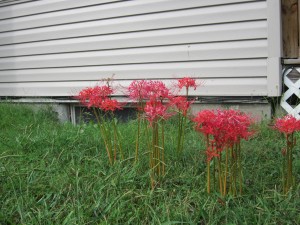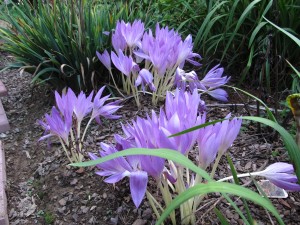Spider lilies (Lycoris radiata) go by a number of colloquial names including resurrection flower, surprise lily, and naked ladies. Naked 1-2 foot tall flower scapes bear 4-6 bright coral-red flowers. Each 2- inch long flower exhibit reflexed tepals and long protruding stamens resembling spider legs (common name “spider lilies”).
Almost overnight, the leafless flower spikes arise in late summer. Several weeks later, strap-like gray-green leaves arise where the floral stalks had been and have now disappeared. Foliage stays evergreen through the winter to feed the below ground bulbs before dying back in spring.
Plant bulbs 9 -12 inches apart in late spring or early fall. Plant them shallow with the neck of the bulb just peaking through the ground. Plants will naturalize by bulb-offsets and form small colonies over time in the southeastern U. S. (USDA hardiness zones 6-10).
Autumn crocus (Colchicum autumnale) is native to Great Britain and Ireland (USDA hardiness zones 4-7). Colchicums bloom in the earliest days of fall often coming up in late August. In late spring, plants send up 4-6 dark green lance-shaped leaves, some which 10- 14 inches long. The foliage yellows and dies down by summer into dormancy. Flower stems with no leaves emerge from the ground to 4-6 inches tall in late summer to early fall bearing goblet-shaped 3 inch long flowers. Flower colors vary from purple to pink to lilac. Weak flower stems tend to flop.
Plant corms 3 inches deep and 6 inches apart in August for bloom that occurs in the same year and many years following. To move or expand an existing planting, mid- to late-summer in the best time.
Both Lycoris and Colchicum grow in organically rich, medium moisture, well-drained soils in full to partial sunlight. Plants respond negatively to soil moisture, preferring dry soils during the summer dormant season and moderate soil moisture during bloom period in late summer. Provide a minimum of 4-5 hours of sunlight for high flower count.
Colchicums (autumn crocus) are not be confused with the true autumn crocus or saffron crocus (Crocus sativus) that also bloom around the same time. The latter are edible and closely related to the spring-flowering crocuses. All plant parts of colchicum are highly poisonous
Neither lycoris or colchicums have serious insect or disease problems. In a wet summer slugs and snails may become significant troublesome pests.



 Posted in
Posted in 
